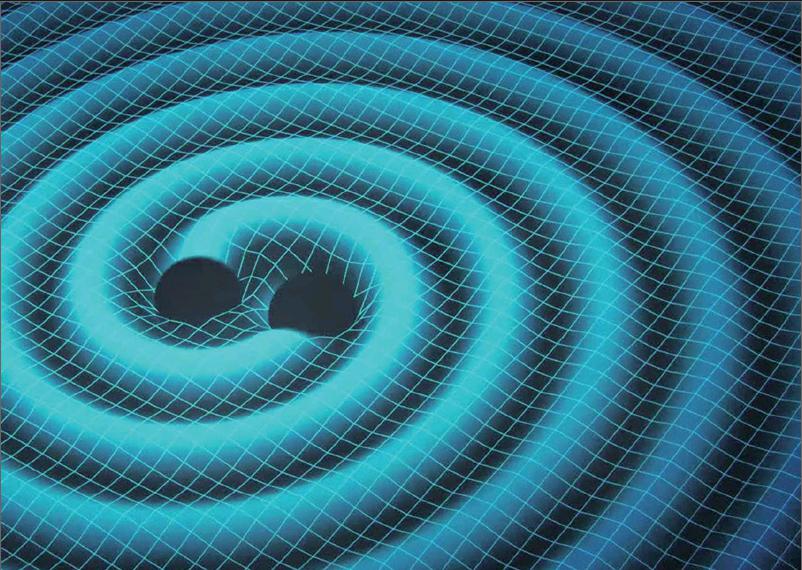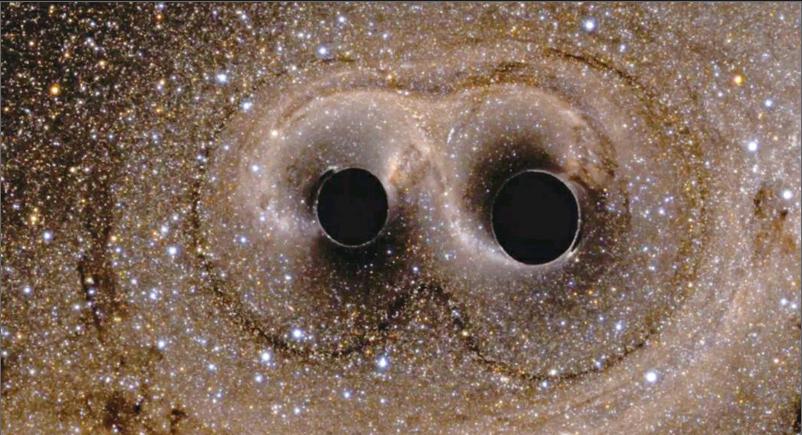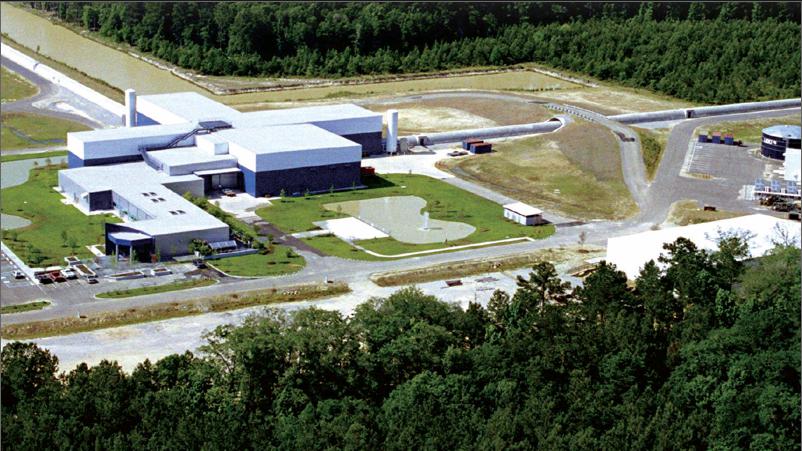引力波:宇宙中看不见的涟漪
Harrison+Smith+两袖清风



You probably heard the news recently: Scientists detected something called gravitational waves, and they are over the moon1) with joy.
So, what's a gravitational wave?
Well, says Kelly Herbst, a physicist and astronomy curator2) at the Virginia Living Museum in Newport News, it's a little complicated. "You can't really feel these gravitational waves. They're not like ocean waves hitting you."
Yet the waves are strong enough that they change the very fabric3) of the universe.
Herbst explains: "The fabric of space is kind of like a big rubber sheet4). You put a bowling ball on the sheet, and it makes this big indentation5)." Drop the ball, or roll it around, and you may see small ripples on the sheet. Other objects—think of them as being the size of tennis balls or marbles—are affected by those ripples. They may bob6) up and down or move a little to the side as the ripple passes through.
Those ripples are just like gravitational waves.
It takes a massive object—a bowling ball, not a marble—to form waves that scientists can detect. In this case, it was a pair of black holes that spun around each other faster and faster, eventually merging7) to become one.
Black holes are extremely dense. These particular ones each had the mass of about 30 suns.
Because they're so dense, they have a powerful gravitational pull. Like hungry hippos eating everything that comes near, they suck in planets, stars and anything else that crosses their path. Incredibly, even light gets sucked in. That is how black holes got their name: Practically8) invisible, they seem to be a patch of empty space in the universe.
When the two black holes combined, a huge amount of energy was released. That energy was released in the form of gravitational waves.
Just as a rock dropped into a pond goes kerplunk9) and sends ripples across the water, gravitational waves spread across the universe. In the case of those two black holes, the waves eventually reached Earth, 1.3 billion light-years from their source.
By then, the ripples were smaller than small.
How small? You may know that living things on Earth are made up of cells, which can be seen only with powerful microscopes. In turn, those cells are made up of atoms, the building blocks of matter.
Atoms are so small that we've only recently developed devices to see them. But the nucleus10), or center, of an atom is about 10,000 times as big as the ripple of the gravitational wave.
That tiny movement, the slightest of vibrations11), was observed at a research center called the Laser Interferometer Gravitational-Wave Observatory (LIGO) using a sensitive system of mirrors and lasers. It confirmed a prediction made by the scientist Albert Einstein 100 years ago, but, perhaps more important, it opened the door to a new way of understanding the universe.
The scientists at LIGO, which has facilities in Louisiana and Washington state, were able to translate the vibration caused by the ripple into a sound: a brief chirp12), the faintest echo of a powerful collision that occurred far, far away.
Instead of just watching the sky, Herbst says, we can now listen to it.
"There are things out there that we can't see very well with light. Black holes are a big one," she said. "Now we have a whole new way of 'seeing' the universe without light."
We could soon learn more about these mysterious black holes and about the early history of the universe, according to Herbst.
"It's very exciting to see what happens next," she said.
各位最近可能都有所耳闻:科学家们探测到了一种叫做引力波的东西,为此乐翻了天。
那么,引力波是什么呢?
这个嘛,美国纽波特纽斯市弗吉尼亚自然博物馆天文分馆馆长、物理学家凯利·赫布斯特说,有点复杂。“你无法真切地感受到这些引力波。它们不像海浪那样拍打你。”
然而,引力波的力量又是如此强大,甚至会改变宇宙的构造。
赫布斯特解释说:“宇宙的构造有点儿像一张大的橡胶板。你把一个保龄球放上去,橡胶板上就被压出一个大坑。”将保龄球扔到或者滚到这个橡胶板上,你可能会看见橡胶板上出现许多小涟漪。橡胶板上的其他物体——将它们想象成网球或弹珠大小的物体——会受到这些涟漪的影响。涟漪经过的时候,它们可能会上下起伏或往旁边移动一点点。
引力波就好比是这些涟漪。
只有庞大物体——像保龄球而不是弹珠那样的物体——引发的波才能被科学家探测到。就这次事件而言,引起此次引力波的庞然大物是一对相互绕转的黑洞,二者越转越快,最终合为一体。
黑洞的密度极大。制造引力波的这对黑洞分别拥有大约30个太阳的质量。
由于密度很大,这两个黑洞具有强大的引力。它们就像饿起来就会吃掉靠近自己的所有东西的河马一样,吞掉行星、恒星以及其他所有经过它们轨道的物体。不可思议的是,它们连光也能吞没。黑洞之名就是由此而来的:它们几乎是不可见的,好似宇宙中的一块空缺。
这两个黑洞合并时释放出一股巨大的能量,这种能量便是以引力波的形式释放出来的。
就像一块石头“咕咚”一声掉进池塘会激起满池涟漪一样,引力波也会在宇宙中扩散。此次事件中,这两个黑洞制造的引力波最终到达了地球——距离其源头13亿光年的地方。
此时,这些涟漪已经小得不能再小。
到底有多小?你可能知道,地球上的生物是由细胞构成,这些细胞只有借助高倍显微镜才能看到。细胞反过来又由原子构成——原子是构成物质的基本微粒。
原子实在太小了,直到近些年我们才研制出观察它们的设备。但就是原子的核,或者说中心,也要比这些引力波涟漪大上约10000倍。
这么微小的运动、如此微弱至极的振动当时是由一个名为激光干涉引力波天文台(LIGO)的研究中心利用一套灵敏的反射镜和激光系统探测到的。这一发现证实了科学家阿尔伯特·爱因斯坦100年前做出的一个预测,不过,也许更为重要的是,它开辟了认识宇宙的新途径。
LIGO在美国路易斯安那州和华盛顿州都有设备,LIGO的科学家们能够将引力波涟漪带来的振动转化为声音:一声短促的啾声。这一微弱无比的回响来自于距离我们极为遥远的地方所发生的一场威力强大的碰撞。
我们以前只能观测宇宙,赫布斯特说,而现在我们可以去听宇宙的声音了。
“宇宙中有些东西我们靠光是看不清的,黑洞就是一大例子,”她说,“现在,我们有了一种不靠光就能‘观测宇宙的全新方式。”
赫布斯特表示,我们可能很快就会了解到有关这些神秘黑洞和宇宙早期历史的更多信息。
“接下来的发现将会非常激动人心。”她说。

